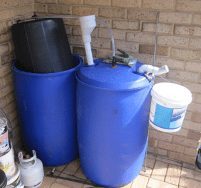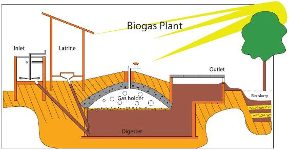Day 50: Renewable Energy I—Methane Production
Dear Student,
One of the most difficult areas to become self-sufficient in on the small homestead is fuel independency.
Solar, wind, and hydropower can be used to power your home with electricity, but fuel for your vehicle, stove, and backup generators is often difficult or time-consuming to produce on farm.
Using a centuries-old technique called anaerobic bio digestion, you can produce methane, a fossil fuel that replaces gas, from farm wastes relatively easily.
Anaerobic digestion is a simple process whereby organic wastes can be turned into a useable energy resource. Many wastes can be upcycled to produce biogas, and the processed wastes are turned into valuable fertilizers, the pathogens therein are destroyed, and the need for smoky wood fuel for cooking is eliminated.
Bio digestion turns foodstuffs, manure, and plant wastes into biogas and fertilizer. The biogas can be used in boilers, burners, generators, engines, and for refrigeration; it replaces propane and butane in these processes.
Small bio digesters are used worldwide, especially in developing countries.
How It Works
In a methane digester, waste products (called feedstock) are broken down by bacteria that produce carbon dioxide (Co2), methane (CH4), water vapor (H2O), hydrogen sulfide (H2S) and sometimes ammonia (NH).
Absorption cooling is used in refrigeration, and burning the methane to produce heat replaces the requirement of running an electrical compressor to produce cold like in a regular fridge. Propane RV stoves commonly run this way.
PH and temperature are important factors in running a methane digester. Cold weather slows and even stops the digestion process. In temperate climates, a heat source will be necessary during winter.
PH is the degree of acidity of alkalinity of the feedstock (7.5 to 8 is best). If the mix becomes too acidic, add lime (calcium carbonate or other) over several days, as the effect of the lime is slow release. Even baking soda can work if your digester is a small, home-sized one.
Small-scale bio-digesters are a lot simpler to use on a small scale than on a large, industrial one. The larger you go with bio-digesters, the more chance there is of complications with their operation. Smaller units are also often cheaper to run, as your feedstock can be sourced for free from your own homestead.
Bio Gas Production
Bio gas is produced in the anaerobic respiration of bacteria and archaea in an anaerobic environment. Bacteria do 99% of the work. Septic systems and sewage treatment works operate on a similar concept, but they don’t collect the methane generated in the digestion process.
Stages of anaerobic digestion:
- Hydrolysis: the breakdown of the feedstock into sludge.
- Acidogenesis: Fermentation stage that releases the volatile fatty acids and alcohols.
- Acetogenesis: Bacteria breakdown the released fatty acids and alcohols.
- Methanogenesis: bacteria convert hydrogen and acetic acid into methane, carbon dioxide, and some trace gasses.
The best quality feed stocks require a carbon to nitrogen ratio (C:N) of 30:1 dry weight.
| Green (High Nitrogen Wastes) | Brown (High Carbon Wastes) |
| Food Scraps 17:1 | Straw 90:1 |
| Aged Chicken Manure 7:1 | Leaves 70:1 |
| Grass Clippings 25:1 | Sawdust 500:1 |
| Coffee Grounds 25:1 | Shredded newspaper 170 : 1 |
| Vegetable wastes 25:1 | Peanut shells 35:1 |
| Fruit Waste 30:1 | Pine Needles 80:1 |
| Fresh Weeds 20:1 | Corn Stalks 60:1 |
| Humus 10:1 | |
| Rotted Manure 20:1 | |
| Garden Waste 30:1 | |
| Seaweed 19.1 |
Using the values above, you can create a mix of waste materials that have an average C:N ratio or around 30:1.
Chopping the material into small pieces or grinding it through a macerator like a kitchen garbage disposal will accelerate the bio-digestion.
There are two general ways to feed a methane digester:
- Continuous Flow: This system is fed feedstock daily and produces methane constantly, expels the spend feedstock automatically, and is better suited to manure-fed systems.
- Batch: This system is stocked with feedstuff, runs, finishes and has to be cleaned out and restocked every time a batch finishes. These systems are cheaper to make and run best on unprocessed plant waste.
There are three general styles of methane digesters:
 Floating Top: This is a cheap system and the most suitable for a backyard homestead with limited feedstocks and a limited output of gas. Here the feedstock is fermented in a bottom tank or barrel, and floating on top is the produced gas in a slightly smaller tank. As more gas is produced, the floating top is lifted higher up, and as the gas is used it lowers. A 55-gallon plastic drum and IBC tanks are idea for this kind of construction.
Floating Top: This is a cheap system and the most suitable for a backyard homestead with limited feedstocks and a limited output of gas. Here the feedstock is fermented in a bottom tank or barrel, and floating on top is the produced gas in a slightly smaller tank. As more gas is produced, the floating top is lifted higher up, and as the gas is used it lowers. A 55-gallon plastic drum and IBC tanks are idea for this kind of construction.- In-Ground Bag: Cheapest and easiest to make at home, the ground bag has a limited life span and is more suitable for warm climates. It resembles a long plastic tube or sausage that is placed in a long shallow channel for stability and protection. It should be covered by a roof for protection from the elements.When building one yourself, it is often made from a rolled sheet of heavy-weight builders plastic or other durable plastic or rubber. Feedstock is fed in one end daily and when full the spent effluent fertilizer extrudes out the other end of the tube.This is a continuous flow system and is better suited for farm production or village production, as many small homesteads don’t produce enough waste to efficiently stock the bag. Pressurizing the gas for direct use adds a small issue here, as the bag fills with low pressure gas. Commercial plastic bladder systems are also commonly used worldwide.
- In-Ground Dome: A system commonly used in Asia but suitable for nearly anywhere, these were traditionally made from concrete or sealed brick and use the insulating properties of the soil it sits in to protect against cold weather. They operate similarly to a septic system.The gas outflow can be passively pressurized by the weight of the water it displaces in the dome, allowing easier utilization of the methane. This system is better suited for small farm production or village production, not small home gas production.Nowadays plastic water tanks and plastic septic systems can be modified to allow home scale dome systems to work efficiently.
Once you have decided which bio-reactor suits your needs and have built it, you can start the biological process.
Process:
- Inoculation: Take waste from a healthy digester and place in your newly built digester to “seed” the correct bacteria into your system and kickstart the process. If you don’t have access to another digester, put a bucket of good compost from the bottom of a compost heap into your new digester.
- Depending on your system, start adding the feedstock (liquefied slurry of shredded foodstuffs, wastes, cardboard, manures, etc.) daily or in a batch.
- Monitor the PH as the system gets going to ensure it doesn’t get too acidic and remedy with lime if it does.
- Monitor the heat of the system and add passive or waste heat if it is too cold (less than 85°F).
- Agitate the slurry regularly to ensure even digestion of the feedstock. This can be done with a handle that is turned outside the digestion tank that moves a paddle or pole on the inside to break up scum or clumps of feedstock inside without allowing gas to escape.
Loading rate is the amount of feedstock you put into the system daily. The formula is: volume of daily input divided by the capacity of the digester.
Pay attention to learn the optimum loading rate for your feedstock and digester design. Don’t overfeed the system, as it will reduce methane production.
In batch systems, you will have to clean out the digester after ever batch, and in a continuous flow system you will have to clean out the system intermittently as it becomes clogged with sludge.
Use waste heat from other on farm processes (like exhaust heat from generators) or solar heat to keep the system operating at optimum efficiency.
Treating And Purifying The Gas
The gas that results from the anaerobic digestion process is a mix of desirable and undesirable gasses. Water vapor and hydrogen sulfide will damage engines and boilers if not removed before using.
Water vapor can be handled by simply installing a pitched outlet pipe out of the digester that forces condensed water in it to run back into the digester and not onwards into whatever engine it might be feeding. You can also run the gas through a glass jar with baffles that will remove the water vapor inline before you burn it.
Hydrogen sulfide can be removed by running the gas through an inline glass jar filled with steel wool (like ordinary kitchen scrubbing pads) or bubbled through an inline jar of sodium carbonate (baking soda or soda crystals) solution that removes the hydrogen sulfide.
Pressurizing The Gas For Use In Engines Or Burners
High-tech options like gas compression and bottling equipment can be used if you are selling the gas or planning to use it in motor vehicles.
Low-tech options like weights on top of the floating gas storage tank can be used if you’re using the gas in your home, farm buildings, or generators and not planning to move the gas offsite or use it in a motor vehicle.
The burning of waste methane is environmentally friendly, as it converts the methane into carbon dioxide, which is twenty times less potent a greenhouse gas than methane is.
The resulting effluent from the digester will be a more stable and balanced fertilizer that can be utilized directly or processed as a compost tea to additionally upgrade its value as a fertilizer.
Biogas Power Equivalency
One cubic meter of biogas at normal atmospheric pressure is representative of the following amount of power:
- Lighting – 60 -100 watt bulb for 6 hours
- Cooking – Cooks 3 meals for a family of 6
- Gasoline – ¼ gallon or 1 liter
- Cranking – 1 horsepower motor running for 2 hours
- Generator – 1.25 kw of electricity
Warning: Biogas is flammable and care should always be taken when handling it. Never smoke close to your bio reactor and make sure it is located in a well-ventilated place.

